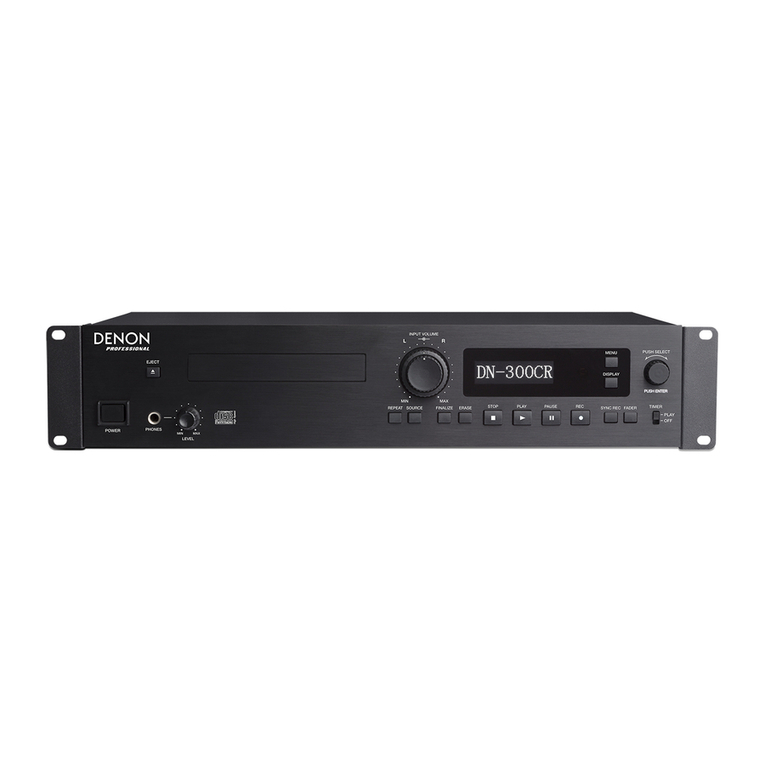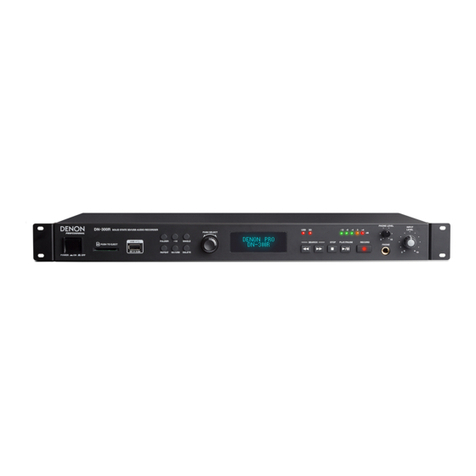Denon Professional DN-7000AVP User manual

User Guide English ( 2 – 13 )
Guía del usuario Español ( 14 – 26 )
Guide d’utilisation Français ( 27 – 39 )
Guida per l’uso Italiano ( 40 – 52 )
Benutzerhandbuch Deutsch ( 53 – 65 )
Appendix English ( 66 – 67 )

2
User Guide (English)
Introduction
Box Contents
DN-700AVP
Power Cable
FM Antenna
Remote Control
User Guide
Safety & Warranty Manual
Support
For the latest information about this product (documentation, technical specifications, system requirements,
compatibility information, etc.) and product registration, visit denonpro.com.
For additional product support, visit denonpro.com/support.
Safety and Precautions
•Keep the unit free from moisture, water, and dust.
•Do not block the ventilation holes.
•Do not let foreign objects fall into the ventilation holes.
Before turning the power on
•Check that all connections are correct and that there are no problems with the connection cables.
•Power is supplied to some of the circuitry even when the unit is set to the standby mode. When leaving
home for long periods of time, be sure to unplug the power cord from the power outlet.
Condensation
•If there is a major difference in temperature between the inside of the unit and the surroundings,
condensation (dew) may form on the operating parts inside the unit, causing the unit not to operate
properly. If this happens, let the unit sit for an hour or two with the power turned off and wait until there is
little difference in temperature before using the unit.
Cautions on using mobile phones
•Using a mobile phone near this unit may result in interference with video and audio signals. If that occurs,
move the mobile phone away from this unit when it is in use.
Operable time for continuous use
•This unit can be used continually for up to 24 hours. Continuing to use this unit for longer than 24 hours
may result in operations failing to function correctly. To continue use for longer than 24 hours, restart the
unit every 24 hours.
Care and cleaning
•Wipe the cabinet and control panel clean with a soft, nonabrasive cloth.
•Benzene, paint thinner, or other solvents may cause discoloration if brought into contact with the unit, and
should not be used.

3
Features
Front Panel
1. Source Select Knob: Turn this knob to select the input source
. Select from Bluetooth, TV, Tuner, DVD,
Dock, BD, SAT/CBL, Game1, Game2, CD, and Multimedia (select from music streaming services, Internet
radio, saved favorite files on a network, media server, or a connected USB flash drive).
2. ON/Standby: Press this button to turn the unit on/off. When the unit is off, it will be in a standby mode.
3. Phone Output: Connect your headphones to this 1/4” (6.35 mm) headphone output.
4. VFD Display: The display is used to show information about the selected audio source, the FM radio station,
Internet radio, setup menus, and various functions.
5. IR Sensor: Aim the remote control here to adjust the unit’s settings.
6. Master Volume: Use this knob to control the master volume of the unit.
7. Zone On/Off: Use this switch to turn zone two on or off.
8. Zone Select: Use this button to select which source input is mapped to Zone 2.
9. Sleep: Use this switch to set the sleep timer in increments of 10 minutes up to 120 minutes.
10. Status: Use this switch to display information about the audio source, HDMI connection, and Unlock status.
11. Tuner -/+: Use these buttons to select the FM radio channel.
12. Dimmer: Use the switch to control the brightness of the VFD display.
13. Media: Use this to switch to a connected USB flash drive, Internet Radio, or media server.
14. Bluetooth: Press this button to pair the unit with a Bluetooth device. Press and hold this button for 3 seconds
to disconnect from a paired Bluetooth device.
15. Quick Selects: Use these switches to select preset audio, video, or HDMI input sources.
16. Key Lock: Press and hold this button for 3 seconds to lock all other switches on the front panel. A message
will be shown on the display indicating that all keys are locked.
17. HDMI IN: Connect a HDMI device to this front panel HDMI input.
18. USB Port: Connect a USB flash drive here with music and picture files. WMA (Windows Media Audio), MP3
(MPEG-1 Audio Layer-3), WAV, MPEG-4 AAC, and FLAC (Free Lossless Audio Codec) are supported.
7
10
10
8 9
11
11
12
12
13
13
14
14
15
15
16
16
17
17
18
18
6
4
5
1
2
3
7
10
8
9
11
12
6
45
12
3
13 14 15
16
17
18
19
20

4
Rear Panel
1. Digital Inputs: Connect devices with coaxial and optical audio inputs here.
2. Network Connector: This connector is used to connect the unit to a LAN (local area network). The port is
used to stream audio from a media server or to connect to Internet radio.
3. Composite Video Inputs: Connect video outputs from a composite video device here.
4. HDMI Inputs: Use these 5 HDMI inputs to directly route the video and audio from a Blu-ray player or DVD
player to the HDMI output.
5. HDMI Out: Connect this HDMI output to a TV, projector, computer monitor, or DVR.
6. Analog Audio Inputs: Connect the audio output of your sound sources here.
7. Serial Port: This input lets you connect a host device (usually a computer) to DN-700AVP. You can use the
host device to control DN-700AVP via commands sent from it (using RS-232C serial communication).
8. Video Out (Composite): Connect this video output to the video input of another video source.
9. Video Inputs (Component): Connect the video inputs to the video output of another video source.
10. Video Outputs (Component): Connect the video outputs to the video input of another video source.
11. FM Tuner Antenna: Connect the included antenna here to get reception for FM radio sources.
12. CD In: Connect these balanced XLR inputs to the output of a preamp or mixer.
13. Input Level Setting Switch: Adjust this to switch the audio input level to -10 dBv or +4 dBu.
14. Balanced Outputs: Connect these individual surround channel XLR outputs to the input of a mixer or
preamp.
15. Balanced Output Level: Adjust this to switch the surround channel XLR output level to -10 dBv or +4 dBu.
16. Power Input: Connect the included power cable here.
17. Zone 2 Outputs: Sends the audio signal from the L/R and subwoofer output to another location.
18. 7.1 RCA Out: Use these coaxial outputs to send individual channels of the surround mix of the audio to a
speaker setup (75W per channel).
19. Bluetooth Antenna: The integrated antenna is used for Bluetooth reception.
20. Firmware Update: The “Service/Normal” switch is used to set the mode for the USB connection for the
firmware upgrade. For normal operation, this switch should be left in the Normal position.
7
10
89
11 12 13
14 15 16
17 18
6
4
5
1
2
3
7
10
10
8
9
11
11
12
12
6
4
5
12
3
13
13
14
14
15
15
16
16
17
17
18
18
19
19
20
20

5
Display
1. Decoder Indicators: This illuminates when the respective decoders are operating.
2. Input Signal Indicators: This illuminates when an input signal is detected.
3. Information Display: The input source name, surround mode, setting values, and other information is shown
here.
4. Speaker Indicator: This illuminates when the surround channel speaker is in use.
5. Zone 2 Indicator: This illuminates when Zone 2 is powered on.
6. Master Volume Indicator: This illuminates when the master volume is adjusted.
7. Input Mode Indicators: Sets the audio input modes for the different input sources.
8. HDMI Indicator: This illuminates when playing a source using a HDMI connection.
1
1
2
34
5
6
78
Table of contents
Languages:
Other Denon Professional Recording Equipment manuals




















